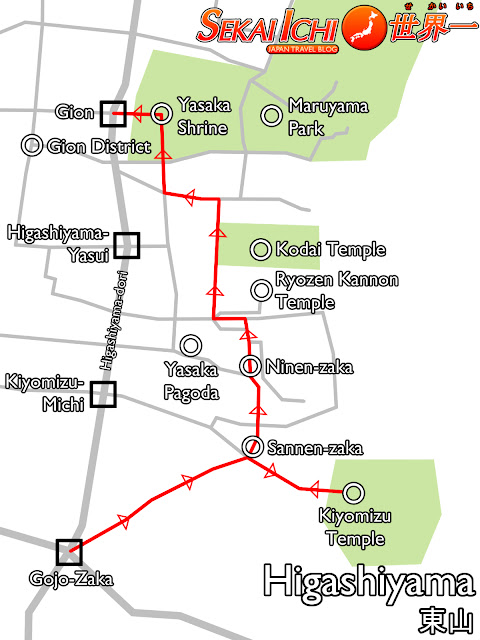Previously on Sekai Ichi, I visited Kiyomizu-dera, one of the most famous temples in all of Kyoto. A natural follow-up for my itinerary was a walk through the Higashiyama district, an historic neighbourhood starting right at the entrance to Kiyomizu-dera. The name "Higashiyama" (東山) means "east mountain", and indeed the area is located along the mountains to the east of the city.
I started my journey by taking a bus from Kyoto Station to the Gojo-Zaka bus stop, and walking up to Kiyomizu-dera. Once I was done there, I went back down the hill, but turned right, into the neighbourhoods. I continued northwards, made a stopover at Kodai-ji temple (which I will describe in a separate article), and wrapped up at Yasaka-jinja shrine. The map above shows the path I took. Multiple bus stops serve the Higashiyama district, and are laid out along Higashiyama-dori, the street running along its west side.
This was the scene at the entrance to Kiyomizu-dera. I take it most of these people were on there way to or from that iconic temple, so you can imagine what it was like over there.
Simply step into one of the side streets, meanwhile, and the crowds thin considerably. Although if this were, say, cherry blossom season (late March and early April), it might be a different story. Most of these roads are for pedestrians only, due to their narrowness. All the better to experience them better, without interruptions!
As part of recent renovations, telephone and electrical wires have all been moved underground, enhancing the olden feel of the neighbourhood. They still need to have those street signs in place, though, but I can live with that.
There are two sets of stairs you will walk across along the way. Ninenzaka (二年坂) and Sannenzaka (三年坂, pictured) mean "two-year slope" and "three-year slope" respectively, and are so named because of a superstition. If you trip and fall on them, you are believed to die in two or three years! Lucky I didn't fall, then! (For what it's worth, I've also read differing interpretations of these names, that they were inaugurated in the second and third years of a given imperial era, so make of that what you will.)
As with the approach to Kiyomizu-dera, the shops along these avenues are mostly cafes and gift shops. There's even a branch of Donguri Republic, the official Studio Ghibli store, nestled in here! But it wan't open yet when I walked by, so instead, have this selfie I took with the kimono-clad mannequin mascot of a different shop.
This is the Yasaka Pagoda (八坂の塔, Yasaka-no-tō, lit. 'eight-slope pagoda'), the only remaining building of Hokan-ji, a former temple. Visitors may pay to enter and climb up the tower, which is actually a rare opportunity among pagodas.
.jpg/640px-Big_buddha_(4180724031).jpg) |
| Martin Abegglen from Bern, Switzerland [CC BY-SA 2.0], via Wikimedia Commons |
Higashiyama has many back alleys to explore. Even if you don't find any place worth visiting, it's still nice to check out the architecture. In fact, I wonder it would be like to live down here...? Actually, I imagine it wouldn't be novel for very long, as even such a setting as this would eventually become the new "normal".
Trees were turning yellow all around the place, including over this house's garage.
The main, historically-preserved path starts at Kiyomizu-dera, and ends here, at Yasaka Shrine (八坂神社, Yasaka-jinja). Pictured here is the dance stage, whose lanterns are lit up every evening. It is also one of the sites featured in the Gion Matsuri festival in July, where a parade of mikoshi (floats) starts from here on the 17th. Most of the events that month, however, take place westward, across the Kamo river.
Turning back a ways, this is the alley in front of Kodai-ji Temple, where I made a stopover. The entrance to this temple was so low-key, I got lost trying to find it, if only briefly. Find out more about it, next time on Sekai Ichi!
Access: From Kyoto Station, take bus #86 (stand D2), #100 (D1), #110 (D1), or #206 (D2) to any of the bus stops between Kiyomizu-michi and Gion (15-20 minutes, ¥230).
Donguri Republic: Kiyomizu Shop
Hours: 10:30AM - 6:30PM. No regular closing days.
Address: 363-22-2 Masuya-chō, Higashiyama-ku, Kyōto-shi, Kyōto-fu 〒605-0826
Website: (Japanese)
Hokan-ji Temple / Yasaka Pagoda
Hours: Open 10:00 AM to 4:00 PM. No regular closing days.
Costs: ¥400
Address: 388 Kiyomizu Yasaka Kami-chō, Higashiyama-ku, Kyōto-shi, Kyōto-fu 〒605-0862
Access: From Kyoto Station, take any of the buses listed above and get off at either the Kiyomizu-michi or Higashiyama Yasui stops (15 minutes, ¥230). Buses #100 and #110 do not stop at Higashiyama Yasui. From either stop, the temple is about 4 minutes away on foot.
Costs: ¥400
Address: 388 Kiyomizu Yasaka Kami-chō, Higashiyama-ku, Kyōto-shi, Kyōto-fu 〒605-0862
Access: From Kyoto Station, take any of the buses listed above and get off at either the Kiyomizu-michi or Higashiyama Yasui stops (15 minutes, ¥230). Buses #100 and #110 do not stop at Higashiyama Yasui. From either stop, the temple is about 4 minutes away on foot.
Ryozen Kannon Temple
Hours: Open 8:40 AM to 4:20 PM. Admission ends at 4:00 PM. No regular closing days.
Costs: ¥300
Address: 526-2 Shimokawara-chō, Higashiyama-ku, Kyōto-shi, Kyōto-fu 〒605-0862
Access: From either of the Kiyomizu-michi or Higashiyama Yasui bus stops, as described above, the temple is about 6 minutes away on foot.
Website: (English) (Japanese)












